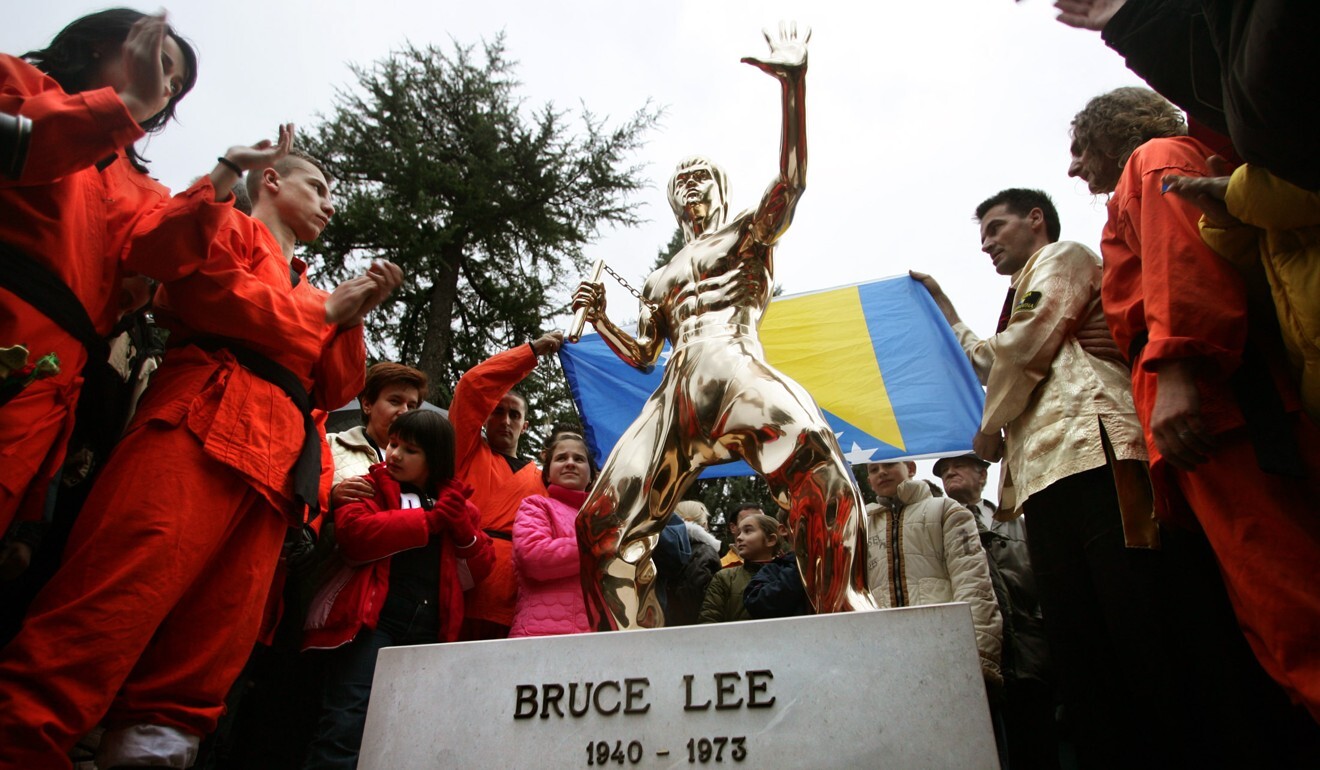
Bruce Lee statue – when Mostar beat Hong Kong to the punch by 24 hours
- Kung fu film star – picked because of his popularity among Bosnian Muslims, Croats and Serbs – has been immortalised globally
- Bosnian bronze unveiled a day before Hong Kong’s in 2005 but fan club were ‘happy to see that others share our love of Bruce’
Where is the world’s first Bruce Lee statue?
Perhaps Hong Kong? Not quite. While the city’s most famous son and his worldwide renown, even 47 years after his death in 1973, is in evidence in his statue on the Avenue of Stars in Tsim Sha Tsui, that was not the first.
That statue, which stands at 2.5 metres tall and depicts Lee in a pose from hit film Fist of Fury, was sculpted in bronze by Cao Chong’en and unveiled on November 27, 2005, the 65th anniversary of Lee’s birth.
Funded by the Hong Kong-based Bruce Lee Club, which raised US$100,000 to fund it, rather than the government, it was unveiled by Lee’s brother Robert.
It quickly became a tourist favourite – or at least it was until the Covid-19 pandemic stopped visitors to the city – and a landmark to the extent that it featured on the Hong Kong episode of several international editions of The Amazing Race.
Since then there have been several other statues around the world to memorialise the kung fu star, who died in Hong Kong aged 32 from a cerebral edema.
Those include one in Los Angeles’ Chinatown, where Lee had opened a jeet kune do studio in the 1960s while on the path to becoming a Hollywood star with his recurring role in The Green Hornet, in September, 2013.
“I am so thrilled to see this Bruce Lee statue finally find its permanent home here in Los Angeles Chinatown. It warms my heart to know that this first ever statue of my father in the United States will stand here in my hometown,” Lee’s daughter Shannon said at its unveiling.
“I am grateful to the LA Chinatown Corporation, Pedro Chan, and everyone who supported this project and helped make this a reality,” she continued via the official Bruce Lee Instagram account.
Another statue of the star in the Sydney suburb of Kogorah, close to the international airport, was unveiled in March, 2011.
The 2-metre bronze was a gift from their twin town of Shunde in Guangdong province – the ancestral home of the Lee family.
This connection is marked on the statue in Chinese: “Originally named Lee Jun Fan, he was born in San Francisco, raised in Hong Kong, and buried in Seattle. His ancestral hometown is in Shunde, China. Lee is the founder of the martial art, Jeet Kune Do. He is honoured as a great martial artist, Kung Fu star and icon of the 20th Century.”
After protests over Lee’s relevance, the council renamed a park as “Shunde Gardens” and moved the statue there to honour the link.
Shunde, itself, can lay claim to the biggest Bruce Lee statue, standing at 18.8-metres tall in the Bruce Lee Paradise park, which opened in 2010, a day after Lee’s 70th birthday.
Interestingly, none of these statues, with their various connections to the life of the global star, was the first.

That went to Mostar, the capital of Bosnia &Herzegovina – and it came a day before Hong Kong honoured its hometown hero.
Mostar was one of the fiercest battlegrounds during the civil war that saw Yugoslavia divided between its various ethnic factions in the early 1990s, with those tensions living on long after the war ended in 1995.
Because of his popularity in Yugoslavia in the 1970s and 1980s, where fans lapped up VHS tapes of films such as Enter The Dragon, Lee was picked as a figure that all of those factions could get behind.
“We will always be Muslims, Serbs or Croats,” Veselin Gatalo, of youth group Urban Movement Mostar, who were behind picking Lee, told the BBC at the unveiling on November 26, 2005. “But one thing we all have in common is Bruce Lee.”
Croatian artist Ivan Fjolic’s bronze stands at 1.68 metres, shorter than the real life Lee, and it was backed by the Chinese and German governments – both of whom sent their ambassadors to Bosnia for the statue’s debut.
Lee is depicted in a fighting stance, which proved a point of contention as Croats and Muslims argued as to which of their respective quarters of the city he was aggressively pointing to. It was vandalised within days at its original site in Zrinjski City Park.
It later toured to Croatia before being given a new location in Mostar.
Hong Kong’s Bruce Lee Club chairman Wong Yiu-keung told the Post that there were no hard feelings toward the Mostar monument, at the Hong Kong unveiling a day later.
“This is not a competition,” he said. “I really appreciate that Bosnia has used the statue as symbol of unity.
“I am just happy to see that other people in the world share our love of Bruce Lee.”
That love continues to this day, as the ESPN 30 for 30 documentary Be Water encapsulated earlier this summer.
There are also growing calls for a statue in San Francisco, where Lee was born, and a more permanent, government-backed memorial here in Hong Kong.

